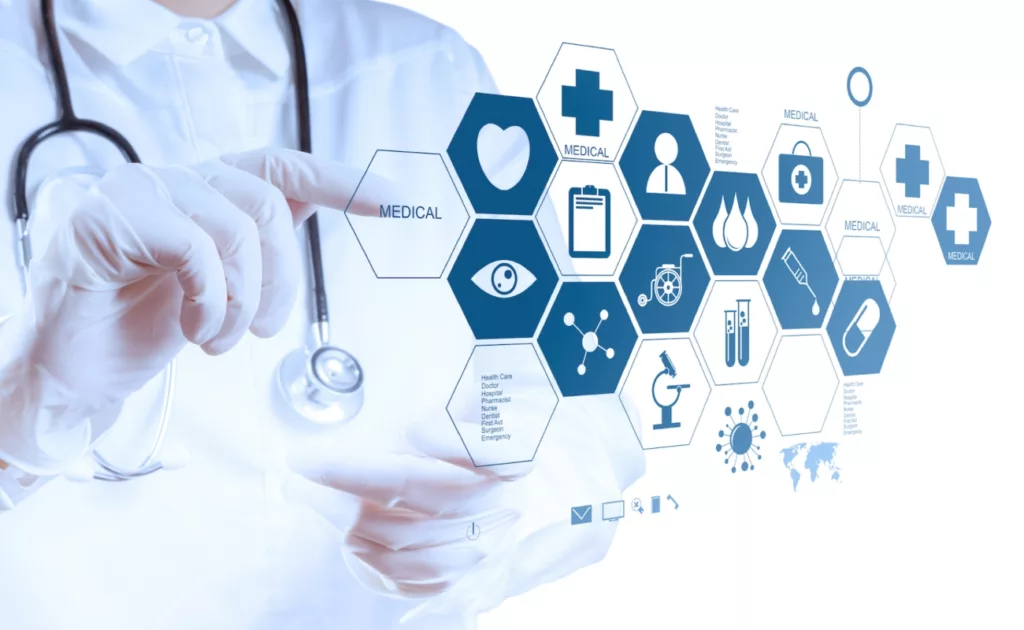Introduction
Healthcare and Information Technology (IT) are two very distinct industries, each offering unique career opportunities. However, there are many career paths at the intersection of these two fields which are worth considering. Healthcare is to save or improve lives, and IT focuses on technologies for processing, storing, managing, or transferring data. This blog post will explore IT opportunities in healthcare and give a broad understanding of the unique career niches. It will highlight some of the important components of a career in Healthcare IT.
What Is HealthCare IT (HIT)?
Healthcare IT is the application of Information Technology to deliver Healthcare services. It forms the framework for the management of a patient’s health information. There are generally two broad aspects to this; Healthcare Technology and Systems And Health Information Technology.
Healthcare Technology and Systems focus on hardware and software that keep the IT infrastructure running. In contrast, Health Information Technology focuses on health data, the information system that houses Health Records. How you efficiently store, manage, share, and protect health records while at the same time keeping track of regulatory laws and regulations.
Healthcare IT is innovative, requiring a combination of technical skills and an underlying passion to deliver better healthcare services to patients.
Importance Of Healthcare IT
Healthcare IT aids in the efficient management of patients’ medical records (as well as other relevant data such as finance, insurance, etc) and makes such records readily and easily accessible to authorized users of such information. Overall, Healthcare IT
- Help Save Lives and Improve Healthcare Delivery
- Make processes in healthcare delivery much more efficient. Facilitates the sharing of health data across multiple platforms with ease.
- Improve access to healthcare by providing accurate decision-making tools
- Reduces the instances of duplicate diagnostic tests and thus helps save cost
- Reduces the need to physically retrieve charts and saves time and cost.
- It helps manage medical records, code for reimbursements, and protect private information.
Technological Innovations in Healthcare
Information Technology is driving a lot of innovations in healthcare. They help remove bottlenecks, improve timely access to valuable patients’ data, and save costs, and overall safety of healthcare delivery. There are a lot of regulations in the healthcare industry so many of these are happening at a much slower rate, especially when you compare these to other industries. These innovations are creating new career opportunities, and they are likely to be much bigger in the future as they gain wider acceptance. Some of these IT innovations in healthcare include;
- Electronic Medical Records and Electronic Health Records
- Telemedicine
- Artificial Intelligence (AI) and Machine Learning (ML)
1a. Electronic Medical Records (EMR) Systems
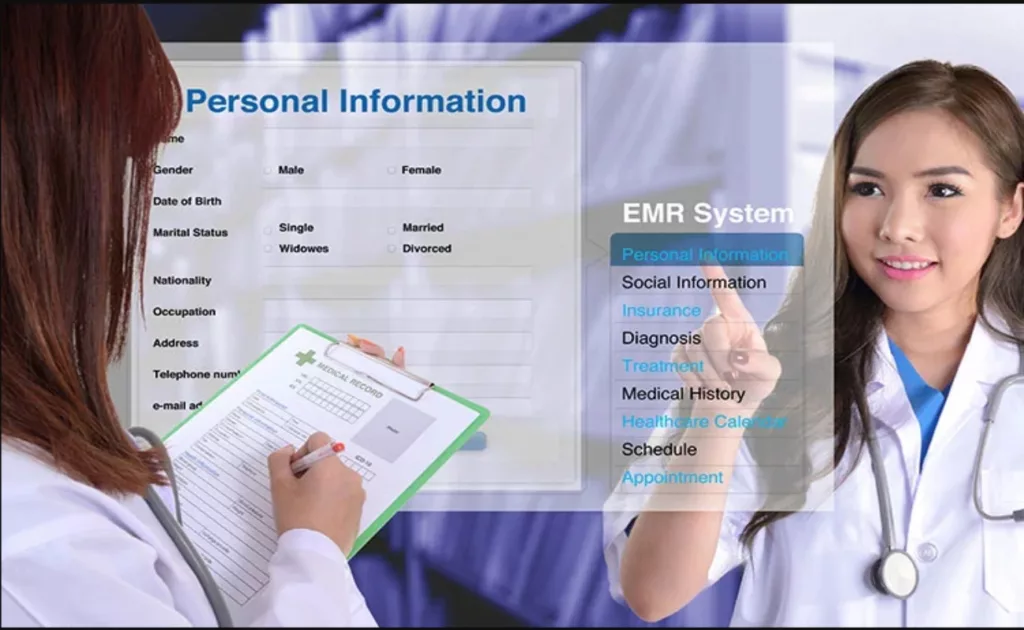
Electronic Medical Records are digital representations of a patient’s medical records. It replaces the old paper (medical) records traditionally used by doctors and clinicians. EMRs are innovative as they remove the need to physically search for a patient’s medical records as you can access every piece of information with just the click of a button. It represents a database maintained by a hospital that contains the following class of information;
- Clinical Records – SOAP notes, prescriptions, surgical reports, immunization records, radiology reports, progress notes, lab results, etc.
- Administrative Information– Appointment history, billing information, Insurance, referral letters, patient information form (PIF), diagnostic and procedure codes, etc.
- Legal Records– living Wills, Informed consent documents, HIPAA (Health Insurance Portability and Accountability Act )forms, Insurance Authorization forms, Record releases, etc
Apart from making patient medical records readily available, the EMR system is also for managing appointments scheduling, billing, ordering tests, etc. You use EMR within one hospital or health facility to manage data. When you want to share a patient’s data with external bodies, the more appropriate system is the Electronic Health Records
1b. Electronic Health Records (EHR) System
The Electronic Health Records system (much like EMR) contains patients’ health records in a digital form and much more information. It allows the sharing of patient data across multiple health facilities including labs and pharmacies. EHR focuses on the total health of the patient. It allows for interoperability and collaboration with other health facilities that may have other fragments of a patient’s records.
According to the Institute of Medicine, the Electronic Health Records system should serve the following 8 core functions;
- Health Information and data management
- Electronic communication and connectivity
- Result management
- Order management
- Decision support
- Patient support
- Administrative processes
- Reporting and population health
EMR VS EHR
The core difference between an EMR and an EHR system is that EHR aggregates all of a patient’s information from multiple sources. It speeds up the seamless sharing of patients’ information across multiple service providers or facilities (and even to external bodies) while EMRs are typically for use only within one health facility. EHR is much more holistic in scope.
From an IT standpoint, an EMR/EHR can either be Server-based where the hospital has its on-prem server to manage its database and enhance privacy, or it can be web-based the EMR/EHR service is provided by a third party such as Cerner (acquired by Oracle), Epic EHR, etc. The Web-EHR or Application Service provider comes with different custom tools offered on a rental basis.
The Electronic Medical Records industry has a market capitalization of over $17.6 billion (2023), with a growth projection to $32.3 Billion by 2033 while the Electronic Health Records market sits currently at $28.1 billion
2. Telemedicine and Telehealth
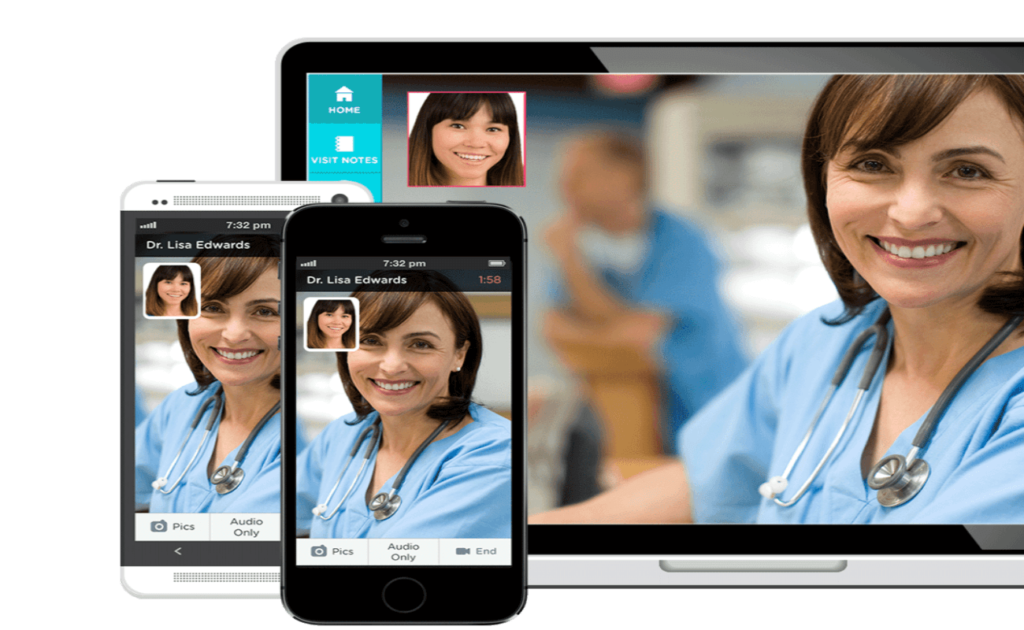
Telemedicine employs the use of electronic communications and software to monitor and treat patients instead of in-patient visits. It allows patients to connect to physicians securely through phone or video conferencing or other electronic means. The idea is to facilitate access to health services from any remote location especially medically underserved areas e.g. rural areas. It is a sub-segment of Telehealth which describes the delivery of medical services and education through digital means (over the Internet).
Although Telemedicine is not available for all kinds of medical services, It does offer additional benefits of being relatively cheaper, saving time, and easy to access – you can access it using your smartphone. It reduces some of the strain on healthcare facilities associated with in-patient visits.
The Telemedicine market has been growing rapidly since the Covid-19 pandemic. More people are getting used to the idea of accessing health services through digital means. According to the US National Library of Medicine, the Telehealth Market estimate will be about $41 Billion in 2024. It is projected to reach $140 Billion by 2030.
Teladoc Health, Doctorondemand, and AmWell are Telemedicine providers in the US.
3. Artificial Intelligence (AI) and Machine Learning (ML) In Healthcare
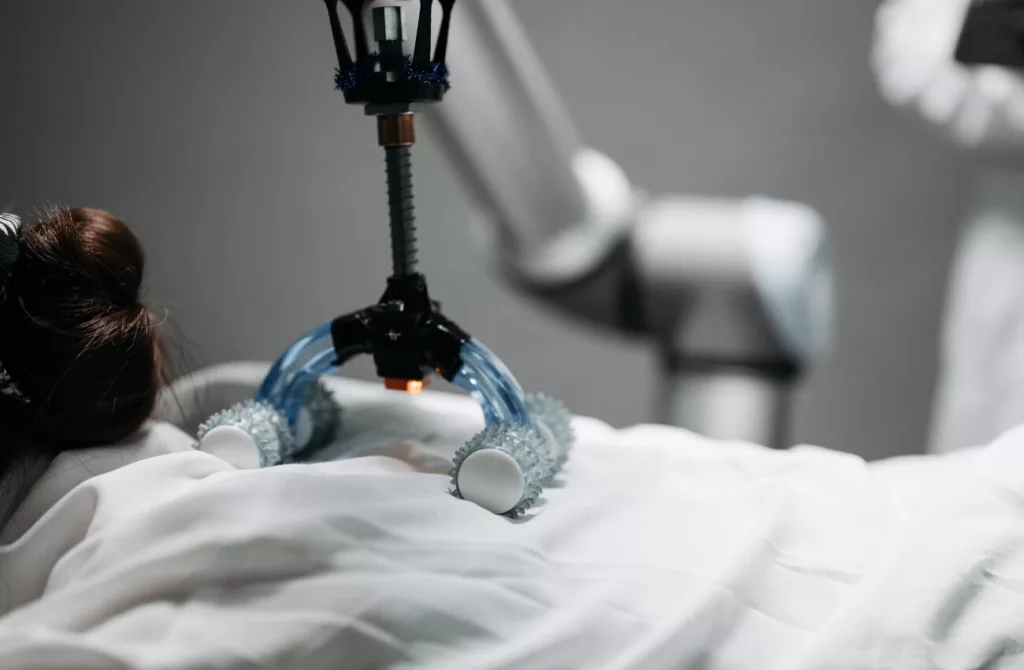
The availability of a large collection of medical data makes it ideal to apply Machine Learning and AI to analyze them and draw useful insights from them. Systems are being trained with medical data to identify patterns, and objects, solve complex problems, make accurate predictions, etc. Two of the most common ways AI and ML are used in healthcare are ;
- Its application in Diagnostics and treatment
- Enhancing personalized medicine through predictive analytics
Some AI can identify specific patterns in diagnostic results, x-rays, scans, etc, and assist doctors in making decisions. There is also the development of personalized medicine for individuals based on their medical records.
Several other AI-powered tools are also assisting health professionals in different ways to save time and resources. For example, the Nuance AI tool is assisting Radiologist in converting their verbal dictations from results into a formal report
Information Technology’s Role in Patient Care
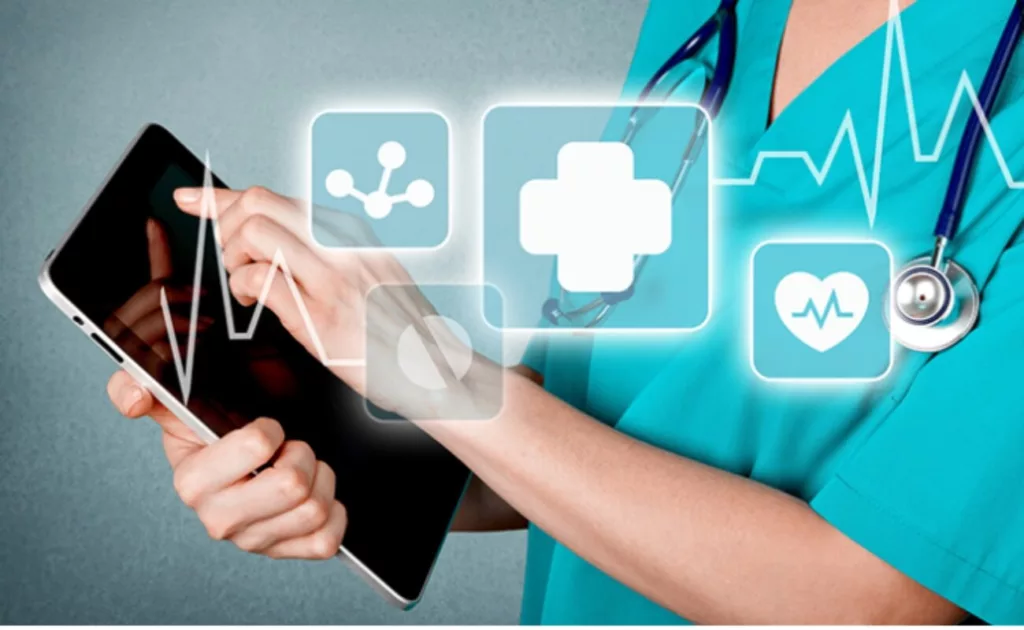
As with other industries, Information Technology can greatly increase access to healthcare services and improve the quality of service delivery. Some of the important roles IT plays in patients’ care are as follows;
1. Remote Patient Monitoring
Remote Patient Monitoring makes it possible for a hospital to continue to offer medical services to Patients who have been discharged from the hospital. Some Remote monitoring devices can be deployed to patients, and with the help of IT, a remote monitoring nurse can track the patient’s progress, and record them, and if need be, necessary changes can be made.
Many hospitals offer Patient Remote Monitoring programs as a way of extending health services beyond the walls of the hospital. The common benefits include;
- Continuously assess a patient’s health after discharge
- As a cost-saving option for managing chronic conditions and for preventive care.
Remote Patient Monitoring, delivered through IT It reduces the need for a clinic visit
2. Health Information Exchange (HIE)
Health Information Exchange allows healthcare professionals and patients to appropriately access and securely share a patient’s medical information electronically (HealthIT.gov). This is ideal for patients and health professionals as medical records of patients are often fragmented across different health facilities. Medical records under HIEs are often protected by Government regulations to ensure safety and privacy. Some of the benefits of Health Information Exchange are as follows;
- Seamlessly sharing patient information among multiple healthcare providers
- Improved care coordination and patient outcomes
Patient health data are often located at different Patient-Centered Data Homes and are coordinated by a centralized Health Information Exchange Organization. The Patient-Cnetered Data Homes facilitate real-time data feed. Health Information Exchange are often hosted in the cloud, and accessed through software or a web interface, to make sure that electronic medical records can be accessed from any location.
Career Opportunities in IT Healthcare

Healthcare IT professionals work to develop, deploy, and manage IT infrastructure and data that aid other healthcare professionals in delivering healthcare services in an efficient, secure, and cost-saving manner. Some of IT career opportunities are as follows;
- Health Informatics Technicians
- Medical Database Administrators
- Health Informatics Consultants
- EHR Consultants
- Clinical Systems Analyst
- Healthcare Systems Analyst
- Nursing Informatics
- Healthcare Project Manager
1. Health Informatics Technicians/Medical Records Specialists
Health Informatics Technicians are responsible for organizing patients’ medical records, verifying them as complete and accurate, and properly storing/retrieving them. They ensure that such medical records are available to doctors and clinicians when needed. They may also monitor a patient’s health progress to assess the quality of care received and report details to the health service provider.
The typical salary range for a Health Informatic technician in the US is $46K – $72K/yr (According to Glassdoor).
Health Informatics Technicians are the custodians of medical records.
2. Health Systems Analyst
A Healthcare System Analyst is in charge of maintaining the computer systems of the healthcare facilities. They analyze the performance of the computing systems to determine if they are at optimal performance. They also recommend to management if there is a need for an upgrade or scaling up. A Healthcare systems analyst will also research new technologies the hospital may want to use. They collaborate with other IT professionals to improve the performance of the computers in the Health facility
A Healthcare Systems Analyst must be knowledgeable of the different applications within their specialties to be able to troubleshoot them. For example, a Radiology Systems analyst should be able to fix common errors in the software system of the radiological equipment.
The average salary for a Healthcare System Analyst in the US ranges from $79,000-$123,000/yr.
3. Nursing Informatics
Nursing Informatics integrates Nursing Science with multiple information and analytical sciences. They must be knowledgeable about both the nursing practice and different technologies to improve healthcare. The NursinG Informaticist job compasses that of a consultant, Instructor, and Educator who helps maintain and improve systems services and helps other Clinical staff to become better technology consumers. It is a specialty role and you will typically need to have a degree in Nursing or a related field to become a Nursing Informaticist.
The Salary range for Nursing Informaticists in the US is $95,000- $155,000/yr.
4. Medical Database Administrator
Medical Database Administrators are in charge of implementing and maintaining both the operational and clinical databases of the health facilities. The training is typical of a Database administrator but the focus is on enterprise data such as the EHR, EMR, Pharmacy, and Labs systems, etc. They ensure that other authorized professionals can access such data through the different portals.
The salary range for a Medical Database Administrator in the US is 97,000-145,000/yr. (Glassdoor).
Conclusion
Information Technologies in Healthcare service delivery offer some unique lucrative career opportunities while simultaneously helping people to get easier and quality access to healthcare services. Information Technologies drive innovation in healthcare, some of these are Telemedicine, Electronic Medical, and Health Records, and the use of AI in diagnostic and predictive medicine. Some of the career opportunities include Health Informatics Technicians, Medical Records Specialists, Healthcare Analysts, Medical Database Administrator etc.
Photo Credit: https://www.hsph.harvard.edu/ecpe/
More Career-Related Posts

